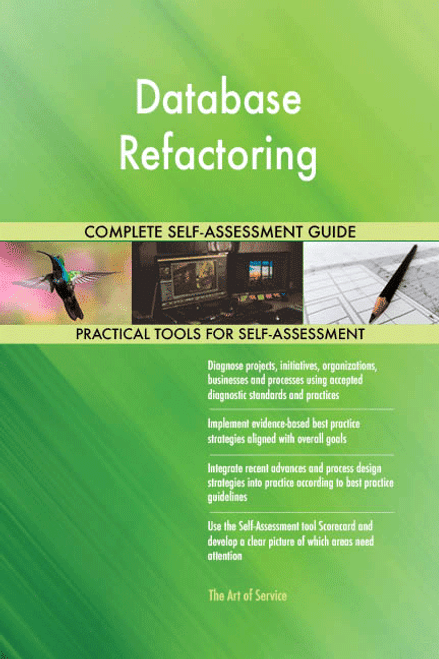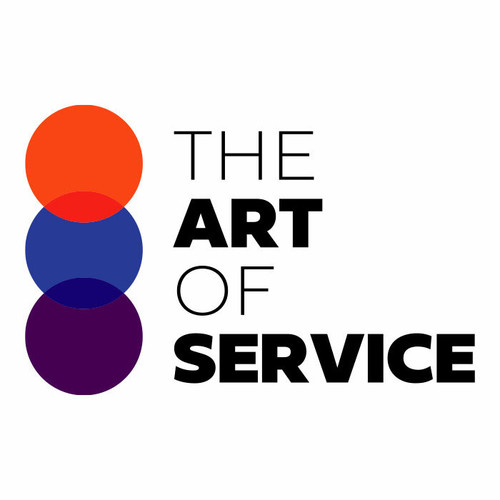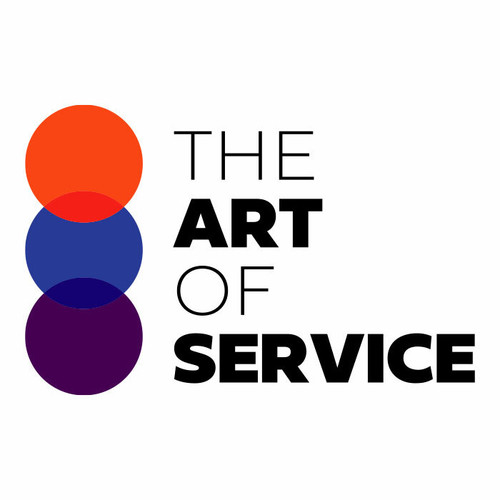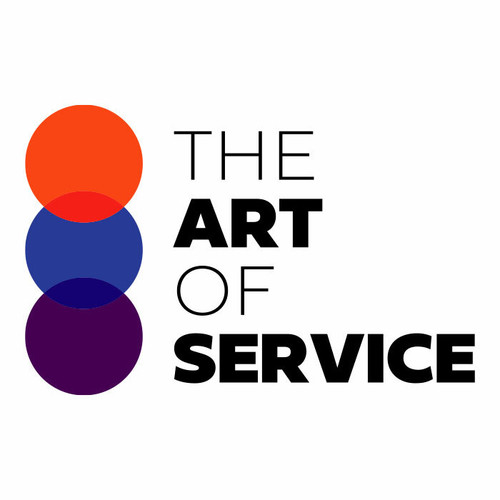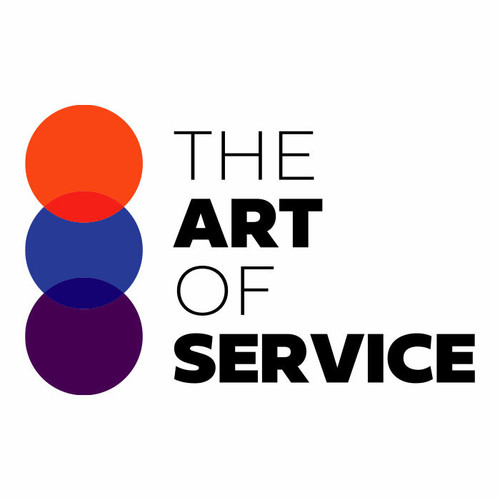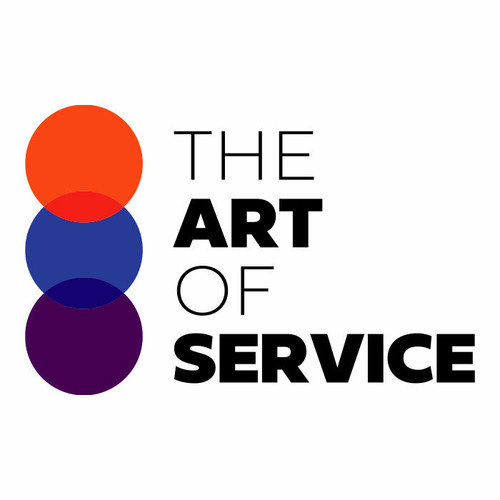Lead Database Refactoring: track and measure performance outcomes and deliver insights on product functionality and use to Product Management.
More Uses of the Database Refactoring Toolkit:
- Evaluate Data Architecture for legacy systems, and lead Database Refactoring efforts by applying enterprise application Design Patterns.
- Assure your strategy complies; with the established organization wide database standards, Best Practices, and Sops and the governing directives of the Enterprise Data Architecture.
- Oversee project database to ensure standards and methodology are being followed.
- Steer Database Refactoring: work closely with Developers, Testers, Architects, Business Analysts and other IT staff to implement Database Administration standards, policies, methods, and procedures building consensus with all parties.
- Collaborate with the Application Development teams and Database Administration to ensure standards for Database Development and databases.
- Steer Database Refactoring: Database Administration, Digital Commerce platform.
- Develop strategies and implement new solutions and technologies to improve underlying infrastructure and Software Development Process as systems for alerting, monitoring, Database Systems, and cloud hybridization.
- Support database initiatives related to security, capacity, scalability, performance, platform upgrades, service agreements, and Disaster Recovery.
- Arrange that your venture deploys the database components for new application implementations and application upgrades to testing and Production Environments.
- Manage work with database team to resolve performance issues, database capacity issues, replication, and other distributed Data Issues.
- Manage work with the Data Center vendor and the application teams to upgrade servers, operating systems, middleware software, database software, and organization applications.
- Methodize Database Refactoring: due to the nature of database software there are many interrelated and interdependent components.
- Control Database Refactoring: maintenance, administration, installation, troubleshooting and configuration of Database Systems and Client Server clusters.
- Be accountable for evaluating plans for database API / Data Services design, development, and implementation using Agile delivery.
- Methodize Database Refactoring: work hand in hand with information technology developers for the implementation and maintenance of Back End database and reporting/analytics environments.
- Pilot Database Refactoring: partner with enterprise Data Analytics, security, and database teams on data encryption, data tokenization, Data Protection strategies and technologies.
- Enter client information into the client database system and submit appropriate documentation to the office broker for file compliance and keep track of transaction activity.
- Assure your team complies; designs, develop, implements, and installs defined Database Systems and maintains enterprise level Database Systems in a multi server environment.
- Develop a conceptual data model, logical data model, and physical data model and support Application Development teams with database queries, troubleshooting, and optimization.
- Perform database activities as setup, configuration, troubleshooting, tuning and optimization, database object creation and modification and Metadata Management.
- Analyze and implement the physical Database Design and structure, ensure enterprise Database Environments are in optimal condition, manage production databases in Client environments, and support complex Problem Solving challenges.
- Engage and coordinate with Database Administrators to baseline and compare production and high availability environments.
- Devise Database Refactoring: work to enhance and optimize the Lead Management process and automation, ensuring timely distribution of leads to sales team, and ensure correct database segmentation.
- Audit Database Refactoring: system Performance Monitoring and Capacity Planning, database installation and configuration, database Backup and Recovery, patch upgrades, security compliance, Audit Trail monitoring.
- Ensure you coordinate; build dynamic, integrated content and using tactics as Lead Generation, Email Marketing, Database Management, Social Media and Community Management, to achieve marketing, sales and brand communication goals.
- Direct Database Refactoring: design, code, and test enhancements for the teradata and aster data Database Management Software.
- Organize Database Refactoring: design, develop and implement database features and tools to provide a secure environment for the product to be used by customers in the cloud.
- Be accountable for performing Cloud Database Performance Tuning.
- Arrange that your design prepares daily deposits and gift processing paperwork for Database Managers.
- Coordinate Data Collection and maintain a database that demonstrates integration with departments, community leaders/organizers, departmental managers and organizations.
- Steer Database Refactoring: team member should be capable of rapidly developing, releasing prototypes while refactoring and fixing/maintaining older code.
- Ensure you have written a multi Channel Marketing strategy for your organization before.
Save time, empower your teams and effectively upgrade your processes with access to this practical Database Refactoring Toolkit and guide. Address common challenges with best-practice templates, step-by-step Work Plans and maturity diagnostics for any Database Refactoring related project.
Download the Toolkit and in Three Steps you will be guided from idea to implementation results.
The Toolkit contains the following practical and powerful enablers with new and updated Database Refactoring specific requirements:
STEP 1: Get your bearings
Start with...
- The latest quick edition of the Database Refactoring Self Assessment book in PDF containing 49 requirements to perform a quickscan, get an overview and share with stakeholders.
Organized in a Data Driven improvement cycle RDMAICS (Recognize, Define, Measure, Analyze, Improve, Control and Sustain), check the…
- Example pre-filled Self-Assessment Excel Dashboard to get familiar with results generation
Then find your goals...
STEP 2: Set concrete goals, tasks, dates and numbers you can track
Featuring 999 new and updated case-based questions, organized into seven core areas of Process Design, this Self-Assessment will help you identify areas in which Database Refactoring improvements can be made.
Examples; 10 of the 999 standard requirements:
- Do you identify any significant risks or exposures to Database Refactoring thirdparties (vendors, Service Providers, Alliance Partners etc) that concern you?
- Against what alternative is success being measured?
- Risk factors: what are the characteristics of Database Refactoring that make IT risky?
- What adjustments to the strategies are needed?
- What risks do you need to manage?
- What are the known security controls?
- Are Database Refactoring changes recognized early enough to be approved through the regular process?
- What are the performance and scale of the Database Refactoring tools?
- Will the controls trigger any other risks?
- What are your Best Practices for minimizing Database Refactoring project risk, while demonstrating incremental value and quick wins throughout the Database Refactoring project lifecycle?
Complete the self assessment, on your own or with a team in a workshop setting. Use the workbook together with the self assessment requirements spreadsheet:
- The workbook is the latest in-depth complete edition of the Database Refactoring book in PDF containing 994 requirements, which criteria correspond to the criteria in...
Your Database Refactoring self-assessment dashboard which gives you your dynamically prioritized projects-ready tool and shows your organization exactly what to do next:
- The Self-Assessment Excel Dashboard; with the Database Refactoring Self-Assessment and Scorecard you will develop a clear picture of which Database Refactoring areas need attention, which requirements you should focus on and who will be responsible for them:
- Shows your organization instant insight in areas for improvement: Auto generates reports, radar chart for maturity assessment, insights per process and participant and bespoke, ready to use, RACI Matrix
- Gives you a professional Dashboard to guide and perform a thorough Database Refactoring Self-Assessment
- Is secure: Ensures offline Data Protection of your Self-Assessment results
- Dynamically prioritized projects-ready RACI Matrix shows your organization exactly what to do next:
STEP 3: Implement, Track, follow up and revise strategy
The outcomes of STEP 2, the self assessment, are the inputs for STEP 3; Start and manage Database Refactoring projects with the 62 implementation resources:
- 62 step-by-step Database Refactoring Project Management Form Templates covering over 1500 Database Refactoring project requirements and success criteria:
Examples; 10 of the check box criteria:
- Cost Management Plan: Eac -estimate at completion, what is the total job expected to cost?
- Activity Cost Estimates: In which phase of the Acquisition Process cycle does source qualifications reside?
- Project Scope Statement: Will all Database Refactoring project issues be unconditionally tracked through the Issue Resolution process?
- Closing Process Group: Did the Database Refactoring Project Team have enough people to execute the Database Refactoring project plan?
- Source Selection Criteria: What are the guidelines regarding award without considerations?
- Scope Management Plan: Are Corrective Actions taken when actual results are substantially different from detailed Database Refactoring project plan (variances)?
- Initiating Process Group: During which stage of Risk planning are risks prioritized based on probability and impact?
- Cost Management Plan: Is your organization certified as a supplier, wholesaler, regular dealer, or manufacturer of corresponding products/supplies?
- Procurement Audit: Was a formal review of tenders received undertaken?
- Activity Cost Estimates: What procedures are put in place regarding bidding and cost comparisons, if any?
Step-by-step and complete Database Refactoring Project Management Forms and Templates including check box criteria and templates.
1.0 Initiating Process Group:
- 1.1 Database Refactoring project Charter
- 1.2 Stakeholder Register
- 1.3 Stakeholder Analysis Matrix
2.0 Planning Process Group:
- 2.1 Database Refactoring Project Management Plan
- 2.2 Scope Management Plan
- 2.3 Requirements Management Plan
- 2.4 Requirements Documentation
- 2.5 Requirements Traceability Matrix
- 2.6 Database Refactoring project Scope Statement
- 2.7 Assumption and Constraint Log
- 2.8 Work Breakdown Structure
- 2.9 WBS Dictionary
- 2.10 Schedule Management Plan
- 2.11 Activity List
- 2.12 Activity Attributes
- 2.13 Milestone List
- 2.14 Network Diagram
- 2.15 Activity Resource Requirements
- 2.16 Resource Breakdown Structure
- 2.17 Activity Duration Estimates
- 2.18 Duration Estimating Worksheet
- 2.19 Database Refactoring project Schedule
- 2.20 Cost Management Plan
- 2.21 Activity Cost Estimates
- 2.22 Cost Estimating Worksheet
- 2.23 Cost Baseline
- 2.24 Quality Management Plan
- 2.25 Quality Metrics
- 2.26 Process Improvement Plan
- 2.27 Responsibility Assignment Matrix
- 2.28 Roles and Responsibilities
- 2.29 Human Resource Management Plan
- 2.30 Communications Management Plan
- 2.31 Risk Management Plan
- 2.32 Risk Register
- 2.33 Probability and Impact Assessment
- 2.34 Probability and Impact Matrix
- 2.35 Risk Data Sheet
- 2.36 Procurement Management Plan
- 2.37 Source Selection Criteria
- 2.38 Stakeholder Management Plan
- 2.39 Change Management Plan
3.0 Executing Process Group:
- 3.1 Team Member Status Report
- 3.2 Change Request
- 3.3 Change Log
- 3.4 Decision Log
- 3.5 Quality Audit
- 3.6 Team Directory
- 3.7 Team Operating Agreement
- 3.8 Team Performance Assessment
- 3.9 Team Member Performance Assessment
- 3.10 Issue Log
4.0 Monitoring and Controlling Process Group:
- 4.1 Database Refactoring project Performance Report
- 4.2 Variance Analysis
- 4.3 Earned Value Status
- 4.4 Risk Audit
- 4.5 Contractor Status Report
- 4.6 Formal Acceptance
5.0 Closing Process Group:
- 5.1 Procurement Audit
- 5.2 Contract Close-Out
- 5.3 Database Refactoring project or Phase Close-Out
- 5.4 Lessons Learned
Results
With this Three Step process you will have all the tools you need for any Database Refactoring project with this in-depth Database Refactoring Toolkit.
In using the Toolkit you will be better able to:
- Diagnose Database Refactoring projects, initiatives, organizations, businesses and processes using accepted diagnostic standards and practices
- Implement evidence-based Best Practice strategies aligned with overall goals
- Integrate recent advances in Database Refactoring and put Process Design strategies into practice according to Best Practice guidelines
Defining, designing, creating, and implementing a process to solve a business challenge or meet a business objective is the most valuable role; In EVERY company, organization and department.
Unless you are talking a one-time, single-use project within a business, there should be a process. Whether that process is managed and implemented by humans, AI, or a combination of the two, it needs to be designed by someone with a complex enough perspective to ask the right questions. Someone capable of asking the right questions and step back and say, 'What are we really trying to accomplish here? And is there a different way to look at it?'
This Toolkit empowers people to do just that - whether their title is entrepreneur, manager, consultant, (Vice-)President, CxO etc... - they are the people who rule the future. They are the person who asks the right questions to make Database Refactoring investments work better.
This Database Refactoring All-Inclusive Toolkit enables You to be that person.
Includes lifetime updates
Every self assessment comes with Lifetime Updates and Lifetime Free Updated Books. Lifetime Updates is an industry-first feature which allows you to receive verified self assessment updates, ensuring you always have the most accurate information at your fingertips.

